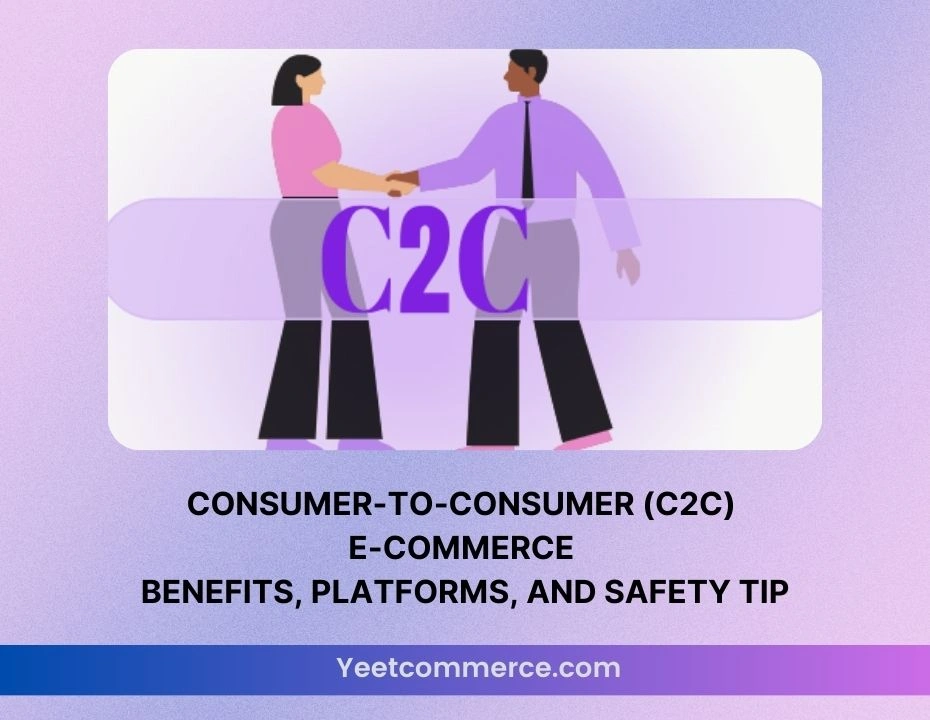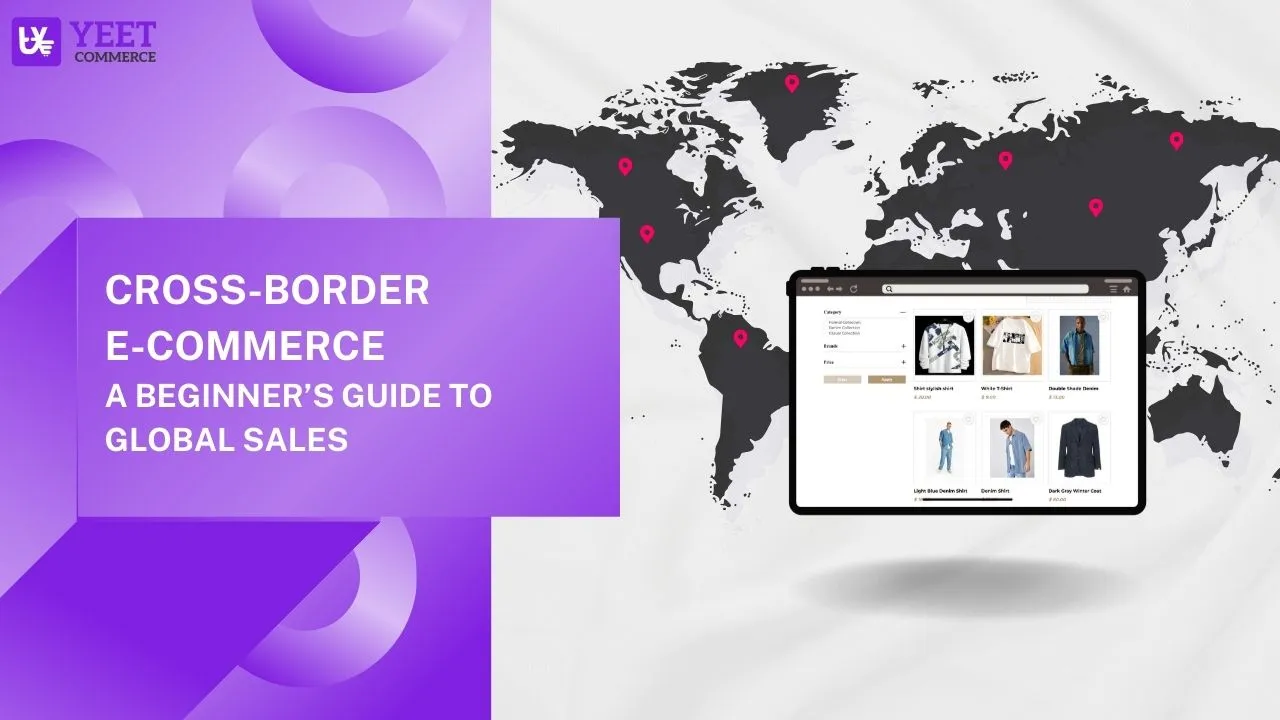In today’s digital age, eCommerce has revolutionized the way we buy and sell goods and services. While most of us are familiar with business-to-consumer (B2C) and business-to-business (B2B) eCommerce, there’s another equally important but often overlooked segment: consumer-to-consumer (C2C) eCommerce. So, what is consumer-to-consumer eCommerce? Simply put, C2C eCommerce is the process of consumers buying and selling directly to each other, usually through online platforms. It has gained significant traction in recent years due to its convenience, accessibility, and the rise of digital marketplaces.
The Basics of C2C eCommerce
Consumer-to-consumer eCommerce involves transactions between individuals rather than businesses. Think of it as an online garage sale, where you can buy a gently used bike from someone across town or sell your vintage comic book collection to a collector in another country. Platforms like eBay, Craigslist, and Facebook Marketplace have made these peer-to-peer transactions easier and more secure. These platforms provide a space for consumers to list their products, negotiate prices, and arrange shipping or pickup, often with some level of buyer and seller protection.
One of the primary attractions of C2C eCommerce is the potential for finding unique or rare items that aren’t available in traditional retail stores. Additionally, it allows you to give your unused items a second life, making it a more sustainable option compared to constantly buying new products. By participating in C2C eCommerce, you contribute to a circular economy where goods are reused and recycled, reducing waste and promoting sustainability.
Significance of C2C eCommerce in the Digital Era
The significance of consumer-to-consumer eCommerce cannot be overstated. For one, it democratizes commerce by empowering individuals to become both buyers and sellers. You don’t need a business license or a physical storefront; all you need is access to the internet and a platform to connect with potential buyers or sellers. This has opened up new economic opportunities for people worldwide, allowing them to supplement their income or even start small businesses with minimal overhead costs.
Moreover, C2C eCommerce platforms often foster a sense of community. They connect people with shared interests and needs, whether it’s trading collectibles, vintage clothing, or handmade crafts. These interactions can lead to more personalized and meaningful transactions compared to impersonal retail experiences. You’re not just buying a product; you’re engaging with another person, learning their story, and perhaps even forming a connection.
Another crucial aspect of C2C eCommerce is its role in promoting financial inclusivity. For individuals who may not have access to traditional banking or retail systems, C2C platforms provide an accessible way to participate in the economy. Mobile payment solutions and digital wallets have further facilitated this inclusivity, allowing users to conduct transactions seamlessly and securely.
How C2C eCommerce Differs from Other eCommerce Models
While B2C and B2B eCommerce models involve transactions between businesses and consumers or between businesses themselves, C2C eCommerce is unique in its peer-to-peer nature. In B2C transactions, a business sells goods or services directly to consumers. This model typically involves large-scale operations, marketing strategies, and supply chain logistics. On the other hand, C2C eCommerce is often more grassroots and informal.
For example, when you purchase a book from an online retailer like Amazon, you’re engaging in B2C eCommerce. However, if you buy a used book from an individual seller on eBay, that’s C2C eCommerce. The main difference lies in who the seller is: a business entity in B2C, and an individual consumer in C2C. This distinction is crucial because it affects the dynamics of the transaction, including pricing, negotiation, and customer service.
Popular C2C Platforms
let’s explore some of the major players in this arena and see how they shape our buying and selling experiences.
eBay: The Pioneer of C2C eCommerce
eBay stands as one of the most iconic and pioneering platforms in the consumer-to-consumer eCommerce space. Launched in 1995, eBay revolutionized the way we think about online shopping by introducing an auction-based model that allows users to bid on items in real-time. Whether you’re hunting for a rare collectible, looking to declutter your home, or hoping to score a great deal on electronics, eBay offers a vast and diverse marketplace that caters to all sorts of needs and interests.
You can easily list items for sale, setting either a fixed price or starting an auction. The platform’s robust feedback system ensures that you can buy with confidence, knowing that sellers are rated based on their previous transactions. eBay also offers buyer protection programs, adding an extra layer of security to your purchases. Its global reach means you can connect with sellers and buyers from all over the world, broadening your opportunities to find exactly what you’re looking for.
YeetCommerce.com: The New Kid on the Block
While eBay has been a household name for decades, newer platforms like YeetCommerce.com are making waves in the C2C eCommerce market. YeetCommerce.com has quickly gained popularity for its user-friendly interface and innovative features designed to enhance the buying and selling experience. The platform focuses on making transactions as smooth and hassle-free as possible, incorporating modern technologies like AI-driven recommendations and real-time chat support to assist users at every step.
One of the standout features of YeetCommerce.com is its emphasis on community. The platform fosters a sense of belonging among its users, encouraging interactions and trust-building through detailed profile pages and community forums. This approach not only helps buyers and sellers connect on a personal level but also promotes a safer and more enjoyable marketplace environment. Additionally, YeetCommerce.com’s mobile app is praised for its sleek design and seamless functionality, allowing you to manage your transactions on the go effortlessly.
Facebook Marketplace: Social Media Meets C2C eCommerce
Facebook Marketplace is another major player in the consumer-to-consumer eCommerce space, leveraging the massive user base of the social media giant. Launched in 2016, Facebook Marketplace integrates seamlessly with your existing Facebook account, allowing you to browse, buy, and sell items within your local community. This integration makes it incredibly convenient for users to jump into the C2C eCommerce world without needing to create a separate account or learn a new platform.
The advantage of Facebook Marketplace lies in its simplicity and local focus. You can quickly list items for sale by uploading photos, writing a description, and setting a price. The platform’s search and filtering options make it easy to find specific items or explore categories of interest. Additionally, because transactions often occur within your local area, you have the option to arrange in-person exchanges, which can save on shipping costs and allow you to inspect items before finalizing the purchase.
Facebook Marketplace also benefits from the trust factor inherent in social media. Since profiles are linked to real people, you can check the seller’s profile and mutual connections, adding a layer of accountability and reducing the risk of scams. The platform’s messaging system allows for direct communication between buyers and sellers, making negotiations and arrangements straightforward and efficient.
Advantages of C2C eCommerce
Understanding what is consumer-to-consumer (C2C) eCommerce opens up a world of unique benefits for both buyers and sellers. This modern marketplace fosters a more personal and direct trading environment, making it a win-win for everyone involved.
Access to Unique and Affordable Products
In the realm of consumer-to-consumer eCommerce, buyers often discover unique products that they wouldn’t find in traditional retail stores. From handmade crafts to rare collectibles, C2C platforms like eBay and Etsy bring together diverse offerings from sellers around the globe. This diversity not only satisfies niche tastes but also often comes at a lower cost. Without the overhead expenses associated with brick-and-mortar stores, sellers can offer products at more competitive prices. This affordability empowers buyers to make choices that suit their budgets and preferences without compromising on quality or uniqueness.
Direct Interaction with Sellers
Another key advantage for buyers in C2C eCommerce is the direct communication channel with sellers. This interaction allows buyers to ask questions, request customizations, and negotiate prices directly, fostering a more personalized shopping experience. Direct contact can also build trust and rapport, leading to smoother transactions and higher satisfaction rates. Unlike traditional retail experiences where buyers often feel like just another customer, C2C platforms make shopping more engaging and rewarding.
Convenient and User-Friendly Platforms
C2C eCommerce platforms are designed with user convenience in mind, offering intuitive interfaces and easy navigation. Whether you’re browsing listings, making a purchase, or communicating with a seller, the process is streamlined for a hassle-free experience. These platforms often include features like secure payment gateways, buyer protection programs, and detailed seller ratings, ensuring a safe and satisfying shopping journey. The convenience of shopping from home or on the go adds to the appeal, making C2C eCommerce an attractive option for today’s busy consumers.
Low Startup Costs and Flexibility
For sellers, one of the most significant benefits of C2C eCommerce is the low barrier to entry. Traditional retail setups require substantial investments in inventory, storefronts, and staffing. In contrast, starting a C2C eCommerce business often involves minimal upfront costs. Sellers can begin by listing items they already own or products they create, with no need for a physical store. This low-risk environment encourages more people to try their hand at selling, whether as a hobby or a full-time venture. The flexibility to sell from anywhere and at any time further enhances this appeal, allowing sellers to manage their businesses according to their schedules.
Wider Reach and Diverse Markets
C2C platforms enable sellers to reach a global audience, vastly expanding their market potential compared to local selling methods. This broader reach means that niche products, which might have limited appeal in a local market, can find enthusiastic buyers from different parts of the world. Additionally, sellers can benefit from the platform’s marketing tools and analytics to optimize their listings and attract more buyers. This exposure to diverse markets not only boosts sales but also provides valuable insights into consumer preferences and trends, helping sellers grow and adapt their offerings.
Building a Brand and Reputation
C2C eCommerce provides sellers with the opportunity to build their brand and establish a reputation over time. By consistently delivering quality products and excellent customer service, sellers can earn positive reviews and ratings, which are crucial in attracting more buyers. A strong reputation can lead to repeat business and word-of-mouth referrals, significantly enhancing a seller’s success. Moreover, the personal touch often associated with C2C transactions can create loyal customer bases that are hard to achieve in more impersonal retail environments.
Challenges and Considerations in C2C eCommerce
Despite its many benefits, consumer-to-consumer eCommerce also presents unique challenges. One of the main issues is trust. When you’re buying from an individual rather than a business, you might be concerned about the quality of the product, the honesty of the seller, or the security of the transaction. To mitigate these concerns, most C2C platforms offer features like user reviews, ratings, and secure payment options.
Another consideration is the potential for fraud or scams. Unscrupulous individuals may take advantage of the anonymity provided by online transactions to deceive others. Therefore, it’s essential to use reputable platforms and exercise caution when engaging in C2C transactions. Reading reviews, checking seller ratings, and using secure payment methods can help protect you from potential risks.
Creating a Sustainable and Collaborative Economy
Consumer-to-consumer eCommerce fosters a sense of community and collaboration that benefits both buyers and sellers. This economic model promotes sustainability by encouraging the reuse and recycling of goods, reducing waste, and supporting small-scale producers and artisans. Buyers get the satisfaction of purchasing unique items while supporting individual sellers rather than large corporations. Sellers, in turn, enjoy the gratification of knowing their products are valued and appreciated by a global community. This collaborative spirit enhances the overall shopping and selling experience, making C2C eCommerce more than just a transaction, but a meaningful interaction.


















